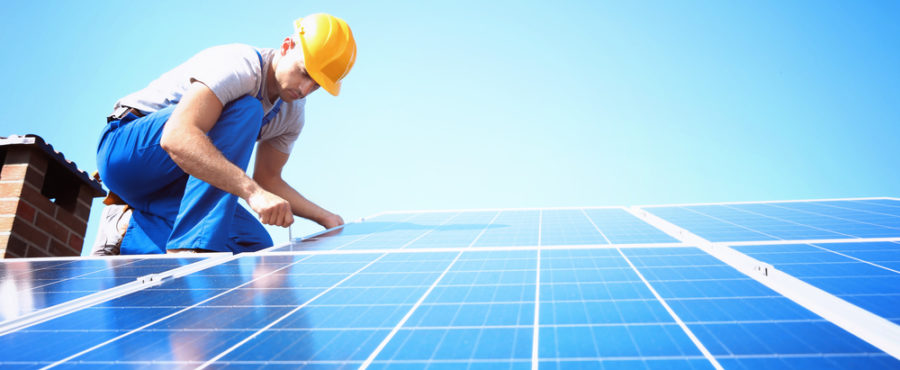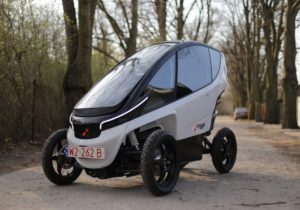
Most everyone knows that solar panels harness the sun’s energy to convert into clean electricity. Did you know that solar panels are not created the same way? It’s true. There are two main types of solar panels that are made: monocrystalline panels and polycrystalline panels.
So what’s the difference between the two? How much do they affect the installation process and is there a difference in how they perform? We’ll answer these questions and a few others to help you decide which solar panel will best fit your home.
How Do Solar Panels Work in the First Place?
Before we can get into the debate of monocrystalline vs polycrystalline solar panels, we should first explain how solar panels work.
Basically, solar panels allow the particles of light (protons) to knock the electrons from the atoms and collect the electrons to generate electricity. This is done with smaller units called photovoltaic cells (PV cells), which generate energy. Each cell is then sandwiched with one or more layers of silicon or another semi-conductive material.
After that, all the PV cells are connected to create a single panel. In order to work though, an electrical field has to be generated. When a different material, like phosphorus, is added, the PV cell gains either a positive or negative charge. These charges work together to create the electrical field.
Finally, metal conducive panels are placed on the sides to collect the electrons, feed them into wires, and allow them to easily be converted into energy. This video has a more detailed and visual description of the manufacturing process.
What are Monocrystalline Solar Panels?
Now that we’ve explained what makes the solar panels work, let’s move onto the differences of solar panels. In reality, the only difference between monocrystalline and polycrystalline panels is how the silicon cells are cut.
Monocrystalline panels are the oldest and most used solar panel technology. As suggested by the name, a monocrystalline panel is created from a single crystalline structure. It is also recognizable by the solar cells that give it a flat-looking color and the rounded edges of each cell.
The monocrystalline solar cells are made from silicon ingots, which are cylindrical in shape. The cylinder ingot is cut into four wafers, which are then used to create the cell. This process is called the Czochralski method, and its the most widely used method.
Because this is the most well-known and used method of solar panel manufacturing, there are quite a few advantages to it:
Pros:
- Have the highest efficiency rates because they are made from highest grade of silicon – The closer together the silicon molecules are aligned, the more efficient the electrons are collected. This is how silicon purity is rated. Monocrystalline panels use the highest silicon grade possible, making it the most efficient.
- They’re space efficient – Since monocrystalline panels are the most efficient, less panels are needed to create the system needed to power the house or business.
- Durability – Most manufacturers put a 25-year warranty on their monocrystalline panels.
- Work better than polycrystalline in low-lighting
- Higher heat tolerance – Monocrystalline tends to have a slightly higher heat tolerance than polycrystalline. This means that in hotter climates, the higher temperatures won’t shorten the lifespan of the panel system by much. However, this isn’t a concern unless you live in desert climates.
Cons:
- More Expensive to Make – Polycrystalline is easier to make and has become more popular in recent years. Monocrystalline is more expensive to make than any other model on the market.
- If a portion of the panel is covered in dirt or debris, the entire circuit can fail – If coverage could be a problem, micro-inverters can make sure the entire system doesn’t go down because of a little shade or debris. This, of course, increases installation costs.
What are Polycrystalline Solar Panels?
Polycrystalline panels are relatively new. They start out similar to monocrystalline panels in that a silicon crystal is placed in a vat of molten silicon.
However, instead of drawing the crystal up from the vat as it’s done for monocrystalline manufacturing, the vat is simply allowed to cool. This is what gives the polycrystalline the distinctive edges and grains in the solar cell.
For years, this way of manufacturing was thought to make panels less efficient in power. In some ways, it does. However, the manufacturing costs of polycrystalline are much cheaper and reduce waste of the original silicon.
In 2015, Trina Solar set a record when they were able to manufacture polycrystalline cells that operated with 21.25% efficiency. This meant they could produce multiple cells that work at 18-20% efficiency, something that was previously thought to be impossible.
This now means, as technology gets better, polycrystalline panels are slowly becoming closer to working at the efficiency of monocrystalline panels.
Pros:
- Manufacturing costs less – Not only does the manufacturing process of polycrystalline panels cost much less than monocrystalline, but the waste of silicon is vastly reduced. Since manufacturing costs less, installation can cost less too.
Cons:
- They are less efficient – Usually, polycrystalline worked at 14-16% efficiency. Now, while they can work at 18-20% efficiency, they’re still slightly less efficient than monocrystalline.
- Lower space-efficiency – Polycrystalline panels usually need more space to cover the electrical output of the house. However, this doesn’t mean monocrystalline panels will perform better than polycrystalline.
- Not as aesthetically pleasing – Due to the uniform look of monocrystalline, polycrystalline is less preferred aesthetically. But this will only matter if you’re actually wanting an aesthetic quality to your system.
- They have a lower heat tolerance – Technically, this means that the lifespan of the panel is shortened. Again though, this isn’t really much of a concern unless you live in a desert climate like Arizona or New Mexico.
To get a summarized version of the advantages and disadvantages of both, this video highlights a lot of what was explained in this section.
Which is The Best Fit?
In the debate of monocrystalline vs polycrystalline solar panels, monocrystalline panels are more efficient and last longer making them the better choice. When you’re deciding what you want to go for, there are a few variables you need to consider:
- Price
- Space
- Amount of shade or debris
- Climate
There’s a few other variables to talk to your installation company about, but these are the main four. So let’s break this down.
Price: Monocrystalline panels are much more expensive than polycrystalline panels to produce. This reflects into your installation bill. It’s for this reason, many people have been turning to polycrystalline because it can be easier and cheaper to produce and install, especially if you have to install extra hardware.
Space: If you have limited space, monocrystalline panels may be something you need to look at. Since they are more efficient, they don’t need as much space as polycrystalline panels do to cover the energy output.
Amount of Shade or Debris: If your roof is a bit shady or you live in a dusty or snowy climate, then polycrystalline might be your best bet. Monocrystalline systems have been known to crash if just a portion of the panel is shaded or covered in dust or snow.
You can install a micro-inverter to prevent this, but that is an extra piece of hardware to the bill, so it’s something to consider.
Climate: Its been discussed that monocrystalline panels are more heat tolerant than polycrystalline. If you live in a hotter climate, this could be an issue as lesser heat tolerance can shorten the lifespan a bit.
Most experts agree this isn’t as much of issue unless it’s a desert climate. However, it could be something to talk to your installation company about to get the facts on in your region.
To Wrap it Up
In this debate of monocrystalline vs polycrystalline, there are a lot of advantages and disadvantages to both. The biggest one, of course, is the efficiency of energy output. Another one is the space efficiency of each design. Overall though, both designs are pretty well matched.
To make a decision, you will need to look at a few variables:
- Price
- Energy efficiency
- Space efficiency
- Climate
- Amount of shade or debris
To find out more information or get a free quote, give us a call at 888-944-6765
And if you have any other questions or feel we might’ve missed something, comment below and let us know[1].
[1] https://www.sunpowerbythesolarquote.com/blog/monocrystalline-vs-polycrystalline-solar-panels




